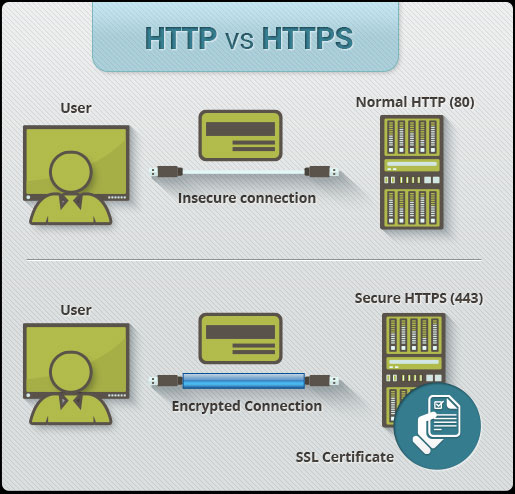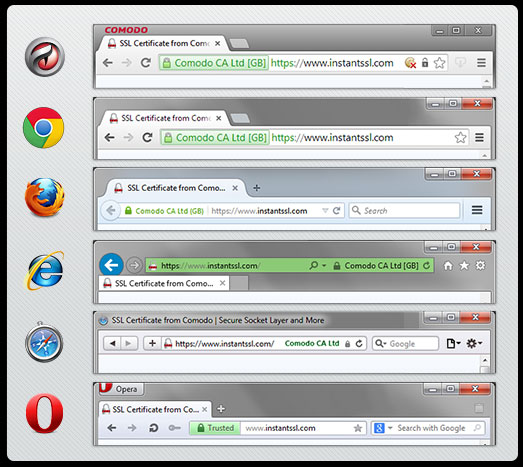What is HTTPS? and why is it needed for your site
Compare HTTP and HTTPS
HTTPS stands for Hyper Text Transfer Protocol Secure, a secure version of HTTP, the protocol by which data is sent between the browser and the website you are connecting to. The 'S' at the end of HTTPS stands for "Secure". It means that all communication between the browser and the website is encrypted. HTTPS is often used to protect highly secure online transactions such as banking transactions and online shopping orders.
Web browsers such as Internet Explorer, Firefox and Chrome also display the padlock icon in the address bar to indicate an HTTPS connection is valid.
- Differentiate HTTPS, SLL, Address bar
- Things you should know about HTTP / 2 protocol

How does HTTPS work?
HTTPS pages often use one of two security protocols to encrypt communications - SSL (Secure Sockets Layer) or TLS (Transport Layer Security). Both TLS and SSL protocols use asymmetric Public Key Infrastructure PKI (Public Key Infrastructure) systems. An asymmetric system uses two 'keys' to encrypt communications, lock 'public' and 'private' keys. Anything encrypted with a public key can only be decrypted by a private key and vice versa.
As the name suggests, the 'private' key needs to be strictly protected and accessible only by the owner of the private key. In the case of a website, the private key is kept private on the web server. In contrast, the public key is distributed to anyone and everyone who needs to be able to decrypt the encrypted information using a private key.
- What is SSL? Is SSL important to the website?
What is HTTPS certificate?
When requesting an HTTPS connection with the website, the site first sends an SSL certificate to your browser. This certificate contains the required public key to start the security session. Based on this initial exchange, the browser and the website will start the SSL handshake protocol (handshake protocol). The SSL handshake protocol involves creating shared secrets to establish a secure connection only between you and the website.
When using a trusted SSL certificate during HTTPS connection, users will see the lock icon in the address bar of the browser. When an Extended Validation Certificate is installed on a web page, the address bar will turn green.

Why should there be an SSL certificate?
All communications sent through HTTP connections are in plain text and can be read by any hacker who can break into the connection between the browser and your website. This can be a danger if it contains contact information located in your order, credit card details or social security numbers. With HTTPS connection, all communications are securely encrypted. This means that even if someone has broken into the connection, they will not be able to decrypt any data passing between you and the site.
Benefits of HTTPS protocol
The main benefit of HTTPS certificates is:
- Customer information, such as credit card numbers, is encrypted.
- Visitors can verify you are a registered business and you own the domain name.
- Get customers' trust and complete purchases from websites that use HTTPS.
You should read it
- Connecting over HTTPS is not necessarily safe
- How to use Fiddler to collect HTTP / HTTPS sessions for debugging
- Firefox is about to mark all HTTP pages as unsafe
- Instructions for setting up HTTPS for simple websites
- Don't believe 7 'myths' about this SSL and HTTPS certificate
- Websites that use HTTP protocol will have to switch to HTTPS if they do not want to 'leak' and 'blacklist' Google
- How does setting HTTPS affect SEO?
- How to turn on HTTPS for your blog site
May be interested
- How to fix This site can't be reached
 how to fix this site can't be reached. during the course of browsing the web, did you ever get the error this site can't be reached? this is a very common error that most of us have encountered at least once, which translates to tr
how to fix this site can't be reached. during the course of browsing the web, did you ever get the error this site can't be reached? this is a very common error that most of us have encountered at least once, which translates to tr - How to enable Site Isolation security feature on Android
 google integrates site isolation feature, or strict site isolation, a security feature from chrome 63 but not enabled by default until chrome 67.
google integrates site isolation feature, or strict site isolation, a security feature from chrome 63 but not enabled by default until chrome 67. - Create a Site-to-site VPN on ISA 2006 (Part 3)
 in part 1, you learned about using the branch office connectivity wizard to create a site to site vpn connection between isa 2006 enterprise edition at the head office and the branch office. part two, we perform the configuration of dns server (server management system numb
in part 1, you learned about using the branch office connectivity wizard to create a site to site vpn connection between isa 2006 enterprise edition at the head office and the branch office. part two, we perform the configuration of dns server (server management system numb - How to enable Site-Specific Browser (SSB) in Firefox
 mozilla has mentioned the site-specific browser (ssb) feature several times over the years, but starting with firefox 73, ssb seems to aim to become a core part of the desktop browser.
mozilla has mentioned the site-specific browser (ssb) feature several times over the years, but starting with firefox 73, ssb seems to aim to become a core part of the desktop browser. - Create a Site-to-site VPN on ISA 2006 (Part 1)
 one of the advanced improvements in the enterprise edition version of the isa firewall is the branch office connectivity wizard (used to connect branches with headquarters for companies). the latest version, isa 2006 has re-integrated components n &
one of the advanced improvements in the enterprise edition version of the isa firewall is the branch office connectivity wizard (used to connect branches with headquarters for companies). the latest version, isa 2006 has re-integrated components n & - How to enable Site Isolation security feature on Chrome
 google released a new version of chrome with a new security feature that separates all websites according to its own process. let's tipsmake.com refer to how to enable site isolation security features on chrome in this article offline!
google released a new version of chrome with a new security feature that separates all websites according to its own process. let's tipsmake.com refer to how to enable site isolation security features on chrome in this article offline! - How to Create a Link With Simple HTML Programming
 once you've created a couple web pages using html, you'll want to connect them into a larger site. learn how to link from one page of your site to another, or to any other site on the internet. you can even send your visitors to a specific...
once you've created a couple web pages using html, you'll want to connect them into a larger site. learn how to link from one page of your site to another, or to any other site on the internet. you can even send your visitors to a specific... - How to Build a Video Hosting Site on Your Windows 2003 Server
 this tutorial guides you to use the flash video encoder for adobe flash (command-line version) to setup a video hosting site for instant video uploading, encoding and exhibition. to setup your video hosting site on a windows 2003 server,...
this tutorial guides you to use the flash video encoder for adobe flash (command-line version) to setup a video hosting site for instant video uploading, encoding and exhibition. to setup your video hosting site on a windows 2003 server,... - Configure IIS for an FTP Site - Part 2
 in this article, i will show you some of the differences in the two versions of the ftp service running on windows server 2008.
in this article, i will show you some of the differences in the two versions of the ftp service running on windows server 2008. - Fix the 'This site can't be reached' error in Chrome browser
 if you are a windows user, when you encounter a 'this site can't be reached' error on chrome browser, you will probably think about losing your network connection and will apply a solution to fix the loss immediately with troubleshooter. however, this troubleshooting process only focuses on scanning the basics such as the connection between the server and your computer and cannot check dns issues so that it can really solve the problem. .
if you are a windows user, when you encounter a 'this site can't be reached' error on chrome browser, you will probably think about losing your network connection and will apply a solution to fix the loss immediately with troubleshooter. however, this troubleshooting process only focuses on scanning the basics such as the connection between the server and your computer and cannot check dns issues so that it can really solve the problem. .










 Instructions for creating web pages in Wordpress from A to Z (Part 2)
Instructions for creating web pages in Wordpress from A to Z (Part 2) Create a simple Website with KompoZer
Create a simple Website with KompoZer Keyboard shortcuts for editing on WordPress
Keyboard shortcuts for editing on WordPress Anyone can create a small and simple website with these 10 websites
Anyone can create a small and simple website with these 10 websites How to create a free website with Google Sites
How to create a free website with Google Sites Want to build an effective, low cost website, apply the following tips
Want to build an effective, low cost website, apply the following tips